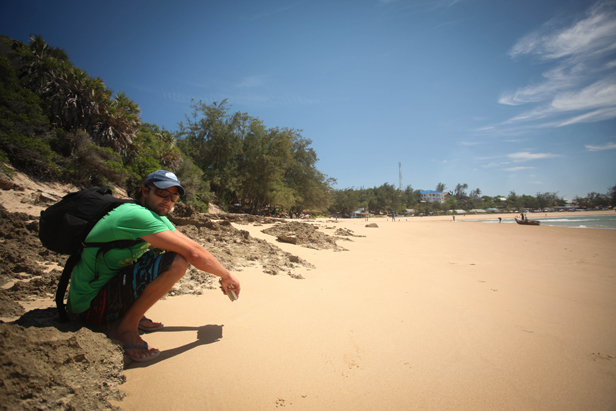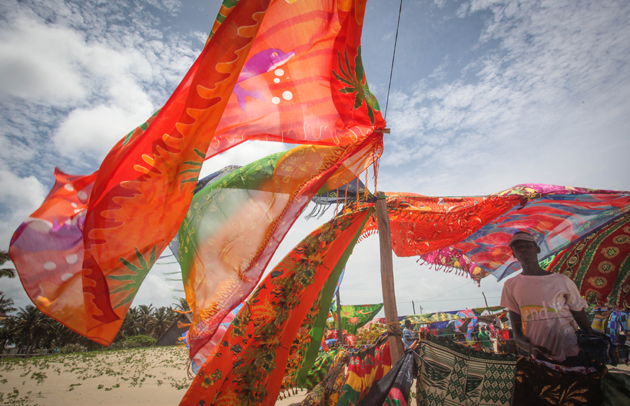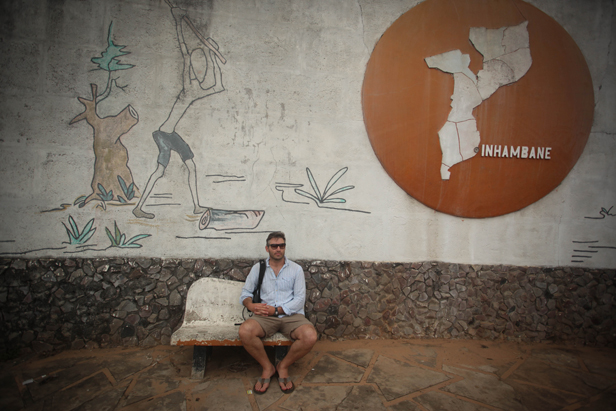Welcome to Tofo, in the Inhambane provice of Mozambique, one of the Southern African holiday circuit towns. Every year around the middle of December every square inch along the sweltering sand tracks are taken up by GP, NP, and MXX license plates. The town becomes a buffet of Toyota, Honda, Hilux and some really strange thing that’s a Hummer look-alike. Jet skis, paddle skis, weird-shaped floaty pools, blow-up dolphins and nefarious quad bikes litter every other unoccupied area of space.
Accommodation in Tofo
Tofo has everything and anything in the way of accommodation from sand-floored backpackers to air-conditioned Jay-Z and Beyonce type cribs with plunge pools, it all depends on how you arrive. The best bet is to get online and hunt down what budget and type of accommodation you want (Find accommodation in Tofo here) and phone or email ahead. The fancier places will often fetch you from the airport or send you maps with GPS co-ordinates. The not-so-fancy places are a simple enough to find, there are signs everywhere or just ask anyone for directions: it’s small enough to navigate on foot.
Tofo is a little South African Ibiza. With mosquitos. And hot. Actually hot is a gross understatement. The thesaurus definitions of hot, when all piled together, might come close to describing the summer heat. Everyone hides in the safety of umbrellas and trees, pumping dance music from loud speakers and 4x4s till the baking sands calm down to a simmer in the cooler evening sun, allowing one to make a mad ‘Jesus lizard’ (Basiliscus basiliscus for those wanting to now google the species) dash to the breakwaters.
Aside from the perpetual party atmosphere however, the reason many people visit Tofo is for the diving. The azure blue, warm water is a pillar of the tourism industry and everyone who arrives to dive hopes for a sighting of the mantas and whale sharks. It’s a treat to be able to dive in rash-vests and board shorts instead of massive amount of insulating neoprene, making the working dives a lot easier to manage without running the risk of frostbite that our Cape waters from home can be so famous for.

Enjoying a walk on Tofo beach towards Tofhino Point
What to pack
Pack for the beach and don’t by any means forget a small bag full of sunscreen, flip-flops, loose and light clothing in long and short sleeves and mozzie repellant (dawn and dusk can be murderous). Don’t forget your mask and snorkel for swimming, as well as anything beach-related like soccer balls, cricket, frisbees, surfboards etc.
When to go
If you want the party atmosphere visit Tofo during any of the long South African holiday seasons, but be sure to book accommodation ahead of time or you will be left high and dry. For those opting for a quieter time, just before and after the South Africa holiday seasons can be wonderful.
For diving
Summer months are from October to April and winter months are from May to September. The absolute best diving is round about April to May when the wind is not too bad, but generally you can dive all year round as long as the wind does not pick up. We used Peri Peri Divers, a young, fun and very informative team who work with Marine Megafauna Foundation whose scientist often accompany divers to catch sighting of whale sharks and manta rays. They’re full of information for you about the underwater world: a great combination.
For the best chance of seeing whale sharks visit Tofo between October and March.

Sarongs dancing in the breeze along Tofo beach
The best of Tofo
Best beer: Make friends with one of the local senoras who own fridges on the side of the street. Negotiate a good price and stick to her, you tend to get special service if you do. Plus they can get hold of all manner of wines and spirits for you.
Best prego: Tofu Tofu is generally the best value for meal spot in town. Watch out though, the busier it gets the slower the service gets, but that’s a general rule all over.
Best pizza: What You Want restaurant. I now dream of their Beach Boy pizza.
Best Local: Behind the fresh fruit and veg market, it doesn’t have a name, but it will be the cheapest meal with the most bulk in town. Their chicken and chips is incredibly tasty, so is the crab and spinach.
Sweet treats: Mozambeats. Great for their chocolate brownies, smoothies and drinks. Great vibe and swimming pool there as well. And movie nights every Wednesday.
Best snack: There’s an internet café on the same road down from What You Want restaurant. Go there for the hand-made chilli chicken pie. Go back again the next day because you know you want to. Also look out for casquihnas and rinsois on any menu. There’s also an ice cream stand. I am not going to tell you where because it’s easy to find and it’s a treat if you do. But get there early or you will miss out.
Inhambane town
The province of Inhambane (roughly 68,615 km² in size) is located along the southern coast of the country, with its capital of the same name found nestled alongside a very lengthy estuary. A ferry connects Maxixe (pronounced mack-sheesh) to Inhambane town. Oddly enough, even though Inhambane is the capital of the province and houses most of the government departments, Maxixe contains all the legal departments concerned with passports and immigration, making it rather backwards and forwards to get legal documents cleared (be warned: the driving round trip looks deceptively short but it can take over an hour).
The layout of Inhambane town is a small and fairly uncomplicated to maneuver around. The beating, sweaty heart is around the main market and taxi rank. As markets go this one is incredibly pleasant, as long as you don’t arrive late in the afternoon heat and have to pass the fish section. It’s a real treat for those sensitive in the nasal department.

Chilling in Inhambane town, waiting for it to cool down
History of Inhambane town
Visited by Vasco da Gama in 1498, this ex-Portuguese colony has existed as a port town since the 10th century, heavily used by the Arabs in the slave trade. You can see the fragment of its colonial past echoed in the architecture, albeit crumbling in some instances, but always colorful and repatriated with African flair. Eclectic and crazy chapas (local taxis) ferry people the distance between Inhambane town center towards the seaside of Tofo and Barra.
The tropical climate inspired Mozambique’s most famous struggle poet and journalist, Craveirinha, to write a lament to the fruit found in the area called The Tasty Tangerines of Inhambane. When the persistent jarring car alarms and whaddha-thump-thump-bom-bom-bom-thump-thump emitting from very large bass speakers dies down, you can imagine kicking back along the wide stretch of beach with toes in the sand, a frosty 2M (local beer) in hand, reading Craveirinha and munching a tangerine, wondering what other people with 9-5 jobs do with their day.
Things to do in Inhambane town
Inhambane is a wonderful town to go and explore. Everything is relatively easy to find from the central market outwards. Take a stroll around, see if you can find the one and only meat supplier in town. His shop just has the word ‘meat’ written on the outside but he has the best and widest selection to get your meat and poultry fix (he also has cheese – real cheese). Also head down the street where you find Pep restaurant. Look for a really garish mint green wall. Inside is a funny little courtyard is a restaurant that has some amazing gourmet burgers. Tip: don’t order just a plain prego if you are hungry. It’s literally bite size. Pep also has large fans to keep you cool from the midday heat.
Getting to Inhambane, Mozambique
Driving
From Johannesburg to Inhambane it takes approximately 11 hours (watch out for public and school holidays, the border will be a long wait). If you’re visiting the Tofo area it’s advisable to go in a 4×4 as the roads can get very sandy.
Flying
It can be anything from an hour and a half to five hours depending on LAM Airlines and if the planes are on schedule, which I have heard can be very temperamental, especially from Maputo to Inhambane.
Find affordable accommodation in Inhambane here
You may also like
Related Posts
The Northern Cape landscape and its characters are full of life. Here are some of...
read more
If you're feeling a bit tired of the usual scene, take a tip from urban...
read more
The east coast is our very own tropical paradise with warm waters and laid-back vibes....
read more